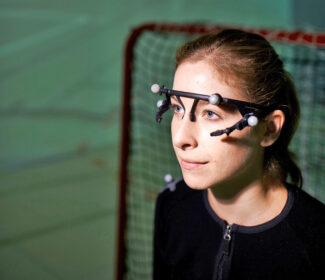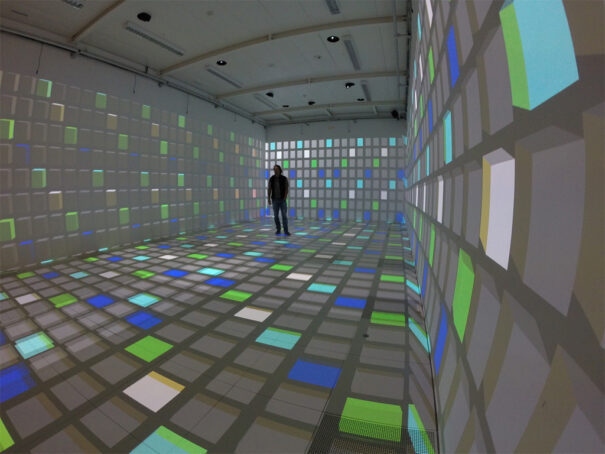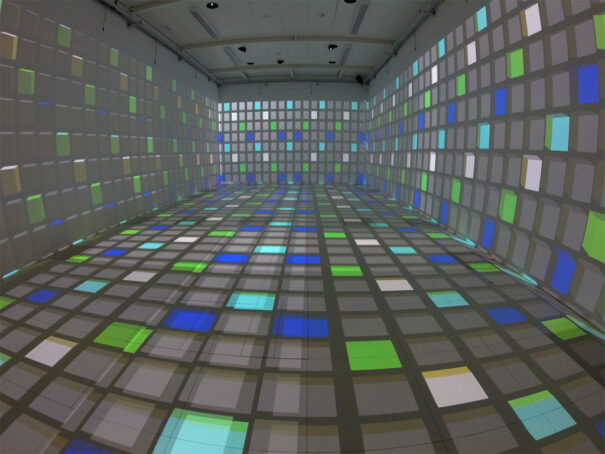The University of Bern uses Scalable Display technology for its Sensorimotor Laboratory
El Instituto de Ciencias del Deporte de la Universidad de Berna de Suiza está revolucionando la investigación a través de la cave de su Laboratorio Sensorimotor. En este proyecto se han estandarizado las soluciones de proyección edge-blending de Scalable Display Technologies para conseguir un entorno visual inmersivo.
 Founded in 1834, the Universidad de Berna ofrece más de 150 títulos de grado, máster y doctorado en diversos campos, a través de ocho facultades, incluidas las de Ciencias Humanas. With more than 19.000 students, es la tercera universidad más grande de Suiza.
Founded in 1834, the Universidad de Berna ofrece más de 150 títulos de grado, máster y doctorado en diversos campos, a través de ocho facultades, incluidas las de Ciencias Humanas. With more than 19.000 students, es la tercera universidad más grande de Suiza.
In the Instituto de Ciencias del Deporte, este se concibe como un tema interdisciplinario. El interés de la investigación se centra en los aspectos sociales y de comportamiento del deporte y el ejercicio en varios campos de la práctica, incluyendo el escolar, el de ocio y de salud, y el de competición.
El Instituto de Ciencias del Deporte ha creado el Laboratorio Sensoriomotor, una infraestructura diseñada para proporcionar conocimientos únicos sobre el comportamiento perceptivo y motor humano en entornos naturalistas complejos.
“Since 2015, hemos estado desarrollando una infraestructura de realidad virtual dirigida específicamente al estudio del comportamiento motor humano en el deporte y el ejercicio”, explica Ralf Kredel, profesor titular del Instituto de Ciencias del Deporte de la Universidad de Berna. “La Universidad de Berna cuenta con muchos estudiantes que dominan el deporte, lo que nos permite seguir de cerca y estudiar el comportamiento motor de la élite mientras practica deporte o hace ejercicio en nuestro Laboratorio Sensoriomotor”.
El Instituto de Ciencias del Deporte utiliza el Laboratorio Sensoriomotor para investigar el comportamiento motor humano desde una perspectiva científica básica y explicar los fenómenos que se manifiestan en el deporte aplicado.
“Las asociaciones deportivas y los atletas acuden a nosotros con preguntas individuales y únicas, a las que tratamos de dar respuesta utilizando nuestro equipo y recursos tecnológicos. Como investigadores, nos interesa comprender los mecanismos generales que hay detrás de estos problemas específicos”, añade Kredel.
El Laboratorio Sensoriomotor de la Universidad de Berna contiene un cave (entorno virtual automático por ordenador), que incluye el seguimiento del movimiento de todo el cuerpo, el ocular móvil integrado, la representación espacial del sonido y doce proyectores de alta resolución para proporcionar un entorno visual inmersivo en las paredes y el suelo de la gran sala.
Introducido inicialmente en 2015, el cave de la Universidad de Berna fue impulsado por un software de desarrollo propio para la mezcla y deformación de la proyección y la visualización de contenidos.
“After, integramos Scalable Display Technologies para mezclar la imagen entre múltiples proyectores en el Laboratorio Sensorimotor”, aclara Kredel. “Antes, utilizábamos un software de desarrollo propio para calibrar manualmente la proyección. Contratamos a un programador que creó un concepto personalizado para manejar la cave, que utilizamos durante tres años. Aun así, queríamos encontrar una forma más eficaz de producir y gestionar el contenido”.
Scalable cumplía todos los requisitos. Necesitaban un sistema que agilizara las operaciones diarias del servicio en el cave, “ya que actualmente soy la única persona que mantiene, desarrolla y gestiona el contenido. Tengo un tiempo muy limitado para las operaciones de servicio y estaba buscando una solución altamente automatizada. Su calibración de un solo toque es ideal para nosotros porque reduce el tiempo de inactividad para el mantenimiento y, often, es lo suficientemente simple para que cualquier persona en el lugar pueda hacer la recalibración por su cuenta”, comenta Kredel
El software de Scalable deforma y combina automáticamente varios proyectores en una pantalla sin fisuras. Permite a la Universidad de Berna crear una solución fiable e interactiva.
“El software de Scalable nos ha permitido agilizar el proceso de calibración e interactuar más estrechamente con la tecnología de vídeo en el Laboratorio Sensorimotor. Nuestra cave es única porque animamos a la gente a interactuar físicamente con ella”, señala Kredel.
La integración con Scalable fue un éxito a todos los niveles. El Laboratorio Sensoriomotor apoya muchas nuevas posibilidades para la investigación y los estudiantes de posgrado de la Universidad de Berna. Permite a los estudiantes de doctorado y de máster crear contenidos interactivos por sí mismos y modificar sus propiedades en tiempo de ejecución. Toma complejos deportes o actividades cotidianas y los hace más accesibles a la investigación. Abre la puerta a un área de investigación completamente nueva para la ciencia del deporte.
You liked this article?
Subscribe to our Feed And you won't miss a thing.
















